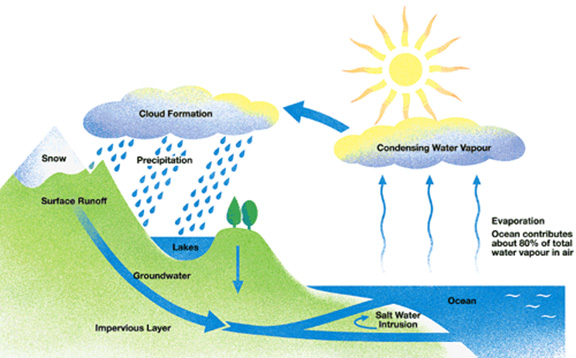Water is the life source for everything on our planet. It is amazing in so many ways. What’s most fascinating is the same quantity of water is on the planet that was at the beginning of time. No new water is created or destroyed. It is simply recycled and reused. This process is known as the Water Cycle. Most of us learned about it in 5th grade science class with a diagram similar to the one below.
The cycling nature of this process helps to filter pollutants from the water. However, increasing pollution in the world is reducing the ability for the Earth to complete this process.
There is No Beginning Point in This Cycle and All Steps Occur Simultaneously, But Let’s Begin with Evaporation.
Phase 1: Evaporation
Liquid water absorbs heat energy from the sun and becomes vapor. And some pollutants, in the water from the runoff phase, evaporate as well. This vapor also mixes with pollution from smoke stacks of industrial and coal fired power plants becoming slightly acidic.
Phase 2: Condensation
At very high altitudes, water vapor changes to particles of water or ice forming clouds and fog. These clouds and fog, which still contain the pollutants, travel by wind all over the world.
Phase 3: Sublimation
Sometimes, ice will convert directly to vapor without turning to liquid first.
Phase 4: Precipitation
The clouds form by the slightly acidic, and polluted condensation and pour down as rain, snow and other forms.
Phase 5: Transpiration
So, as the water falls from the sky, it’s absorbed by soil and fed to plants. If this water is polluted, it contributes to sickly plants, therefore making them sicker rather than better. The extra water leaves the plants in the form of gas.
Phase 6: Runoff
The various forms of water that cannot be absorbed into the soil lead to runoff. And, most of the polluting happens in this phase. Animal waste, discharges from manufacturing, petroleum products from our roads, lawn and agricultural chemicals dissolve into the water and flow into sewers, sinkholes, lakes and rivers.
Phase 7: Infiltration
Any water that plants do not absorb, nor evaporates into the air, as a result seeps into the various sources of our drinking water.
Where Florida Get’s Its Water
We collect our drinking water from the reservoirs and aquifers, which unfortunately have been polluted. Sometimes this water is barely filtered before we introduce it into our homes and our bodies. Even well water can include toxins because of the infiltration phase.
Having a professional filtration system is vital to the well being of your family and home. The experts at Best Water Solutions can design and install a treatment system that removes the above contamination from your water. You will enjoy water that is pure and healthy.
Call us today at Gainesville: 352-372-2707 or Ocala: 352-369-1707 to schedule a free, no obligation water analysis.




